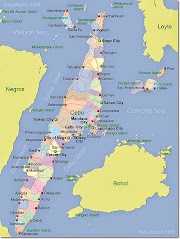A templete (Sp.) or template (Eng.) signifies a certain structure used as a shrine where celebrations are held imbued with historical value and significance. It is referred to as a “small temple”. The word template also bespeaks as a monument that pays homage to a place where important events took place.
This coming November 30, 2012 the National Thanksgiving Celebration of the Canonization of Blessed Pedro Calungsod which will be held in SRP lot, a templete will be constructed mainly as the venue of the Eucharistic Celebration. Besides, this template will serve later as a monument that pays homage to the historical event that took place.
The Templete de Pedro, as I would like to call it, is meant, first and foremost, to inspire the faithful. The structure itself serves as a vessel of meaning both in aesthetic and spiritual value. It carries with it, among others, nuances of theological meaning that have the opportunity to instruct, inspire and catechize.
The basic design of the template is always in relation to the basic plan in general of a church architecture. Since the template serves as a shrine where the Holy Mass is celebrated, it is but proper that the template is patterned to that of the architectural language of a church.
Just like any other church, the template has a sanctuary at the center. This is elevated just to signify its prominence in any area of the structure as the most sacred place. Besides, its higher elevation signifies separation from the nave. In the case of the template, the nave is where the concelebrants are placed. This is situated at its both wings which can accommodate 150 bishop concelebrants in each side. This sanctuary area holds the altar table as the most venerated and holy place in the whole sanctuary. Unlike the altar table in the church which is made of stone and has a sepulchum on it (a small whole at the center of the altar where a relic of a saint is placed), the template altar is just a plain slab of wood with the presider’s chair directly at its back and the ambo at its front. The distinctive and the running design of the altar furniture (the altar table, presider’s chair, ambo and the cross assemble) is a waived palm which signifies inculturation indicated in the many usage of palm in our daily life and industry. At the back of the sanctuary serves as the sacristy where the liturgical materials such as the sacred vessels, liturgical books and the like, are being prepared for the celebration.
Of all the elements in the template, the pyramid-like structure or the spire which is at its center is considered to be the focal piece. This holds numerous iconographic meanings that instruct what martyrdom is all about. In a church structure, one natural law that governs in building church edifice is its verticality. This is inherent in every successful church building that truly inspires the faithful. Verticality speaks about the massing of material and volume upwards that renders it to dominate the horizontal. The soaring height tells plainly of man’s desire to reach Heaven and the spirit’s longing to reach God. This is the whole point of the pyramid-like structure in the template. It speaks about verticality that leads to transcendence that of creating a structure that expresses a sense of the spiritual and the heavenly. Martyrdom is all about transcendence. One can truly deny the self if one, at the same time, transcends the self. Dying due to faith is indeed a transcendence of self that is going across and beyond the border of self interests.
The cross culminates the verticality of the pyramid-like structure or the spire. This is indicative of the relation of the ultimate sacrifice of Jesus in the cross with that of the sacrifice in the martyrdom. All sacrifice due to faith finds its meaning and glory in the sacrifice of Jesus in the cross. The cross is the crowning glory of the death of Pedro as a martyr.
At the center of the spire spreads the palm as the Christian iconographic representation of Martyrdom. It is believed that palm frond or stem is the symbol of victory in the war waged by the spirit against the flesh. The martyrs are then called the victors par excellence over the spiritual foes of mankind.
With all the theological nuances of the Template de Pedro, this structure indicates our pride to have another Filipino saint, a Visayan at this time, to be raised at the Altar of God. A monument of pride and devotion, just like the structure itself, speaks of our longing to achieve victory of faith and our soul’s desire to reach heavens where God and all the martyrs await for all of us.
Viva San Pedro Calungsod!!!




.jpeg)



.jpeg)
0 Comments